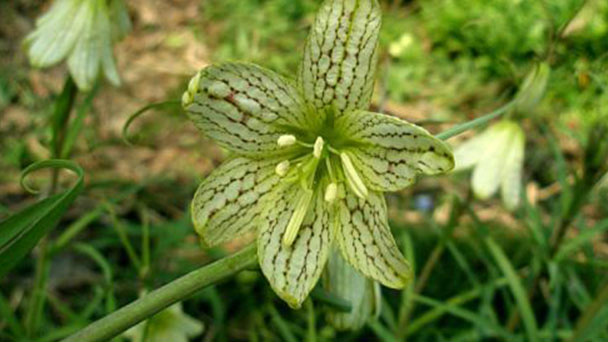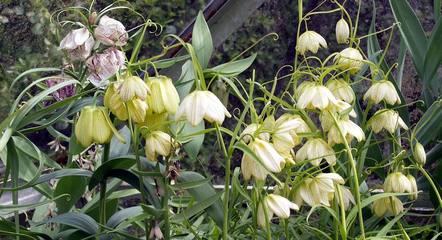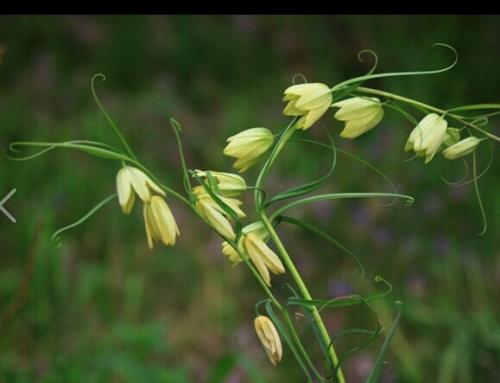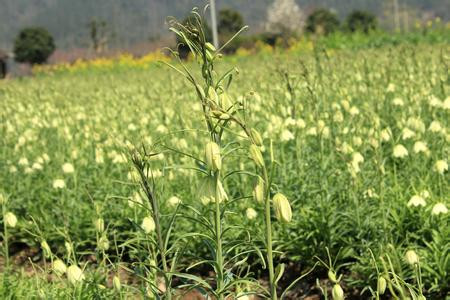Fritillaria thunbergii (Thunberg Fritillary) profile
Written by admin
Mar 30 2021

Fritillaria thunbergii is a perennial herb. The bulb of Fritillaria thunbergii is hemispherical, 1.5 -- 6 cm in diameter, with 2 -- 3 fleshy scales. Stem simple, erect, cylindrical, 50-80 cm tall.
Fritillaria Thunbergii picture

Morphological characteristics of Fritillaria Thunbergii
The plants of Fritillaria thunbergii are 50-80 cm long.Bulbs consist of 2 (-3) scales, 1.5 -- 3 cm in diameter.
Leaves of fritillaria thunbergii at lowest opposite or scattered, often scattered, opposite, and whorled upward, subbanate to lanceolate, 7 -- 11 cm long, 1 -- 2.5 cm wide, apex not curled or slightly curved. Flowers 1-6, yellowish, sometimes slightly lavender, apical flowers with 3-4 leaflike bracts, others with 2; Bracts are apex curled;
Perianth segments of Fritillaria Thunbergii are 2.5-3.5 cm long, ca. 1 cm wide, inner and outer wheel similar; Stamens are about 2/5 of perianth segments;
Anthers of Fritillaria thunbergii subbasely, filaments without papillae;Stigma fissure 1.5-2 mm long.
The capsule of Fritillaria thunbergii is 2 -- 2.2 cm long and 2.5 cm wide, with wings 6 -- 8 mm wide on the edges.
The ecological habits of Fritillaria Thunbergii
Fritillaria thunbergii was born in the shade of hills or under bamboo forests at lower elevations.
Fritillaria Thunbergii prefers a warm, wet, sunny environment.
The root growth of Fritillaria thunbergii requires a temperature range of 7 ~ 25℃, and the root growth is inhibited above 25℃.
When the average ground temperature reached 6 ~ 7℃, the seedling emerged, and the temperature range of shoot growth and development was 4 ~ 30℃. Within this range, the growth rate was accelerated with the increase of temperature.
Fritillaria thunbergii is suitable for flowering at about 22℃. The plants were frozen at -3℃, and the tops of the plants were yellow and withered above 30℃.
The bulb of Fritillaria thunbergii can expand normally at 10 ~ 25℃, but will be frozen at -6℃, and will become dormant at above 25℃.
Both bulbs and seeds of Fritillaria thunbergii are dormant. Bulb from the ground began to wither into hibernation, through the natural summer to September can lift dormancy.
The seeds of Fritillaria thunbergii can also break dormancy after 5 ~ 10℃ for 2 months or through natural overwintering.Therefore, autumn sowing is used in production. Seed germination rate is generally 70% ~ 80%.

Fritillaria Thunbergii propagation
Seed - best sown as soon as ripe in a cold frame, it should germinate in the spring. Protect from frost. Stored seed of Fritillaria Thunbergii should be sown as soon as possible and can take a year or more to germinate. Sow the seed quite thinly to avoid the need to prick out the seedlings. Once they have germinated, give them an occasional liquid feed to ensure that they do not suffer mineral deficiency. Once they die down at the end of their second growing season, divide up the small bulbs, planting 2 - 3 to an 8cm deep pot. Grow them on for at least another year in light shade in the greenhouse before planting them out whilst dormant. Division of offsets in summer. The larger bulbs can be planted out directly into their permanent positions, but it is best to pot up the smaller bulbs and grow them on in a cold frame for a year before planting them out in the autumn.
Varietal classification of Fritillaria thunbergii
East Fritillaria var. chekiangensis Hsiao et K. C. Hsia
Plants shorter, 15-30 cm long; The bulb consists of 3 scales, ca. 1 cm in diameter; The leaves are mainly opposite and easily identifiable.
Zhejiang Dongyang production, local cultivation.Bulb is the source of "Dongbei". East shellfish are exported to Guangdong and used instead of Sichuan shellfish.
The distribution of Fritillaria Thunbergii
Fritillaria thunbergii is found in Jiangsu (southern), Zhejiang (northern) and Hunan.
Fritillaria Thunbergii is also found in Japan.

Latest Updated
- Benefits of Bugleweed - 7 Science-backed Health Benefits
- Bugleweed Dangers & Side Effects - Is It Poisonous?
- How to Plant Evergreen Trees - What You Should Know
- When to Plant Evergreens - Grow Guide for Evergreen Trees
- 12 Wonderful Evergreen Shrubs for Your Garden
- 12 Popular Evergreen Plants with Pictures for Beginners
- When And How To Prune A Lilac Bush Like a Pro
- How to Grow & Care for Lilac Vine (Hardenbergia Violacea)
- Japanese Lilac Tree (Syringa Reticulata) Care & Propagation Guide
- Shumard Oak Pros and Cons - What to Know
Popular Articles
- Winter maintenance of Antirrhinum Majus
- How to Grow Terminalia Mantaly Tree
- How to Grow and Care for Crossostephium Chinense
- How to grow Antirrhinum Majus in spring
- Peristeria Elata (Dove Orchid) Profile: Info & Care Guide
- Underwatered Snake Plant (Sansevieria Trifasciata) - Signs And How To Fix
- How to Care for Brazilian Jasmine Plant (Mandevilla Sanderi)
- How to Grow & Care for Graptopetalum Purple Delight in Summer
- Rosa Chinensis (China Rose): Plant Growing & Care Tips
- How to Care for Baby Sun Rose (Aptenia Cordifolia)